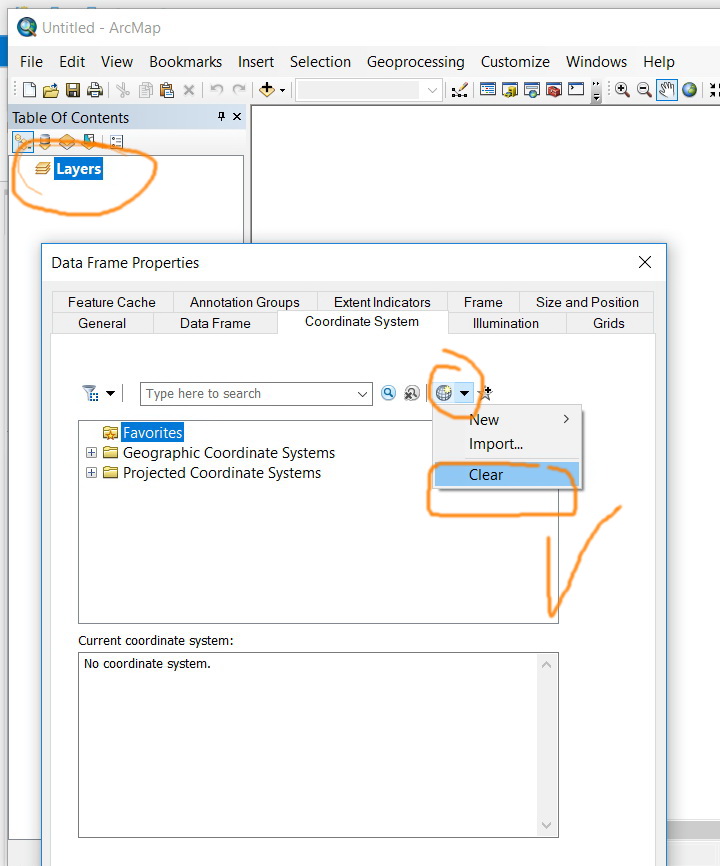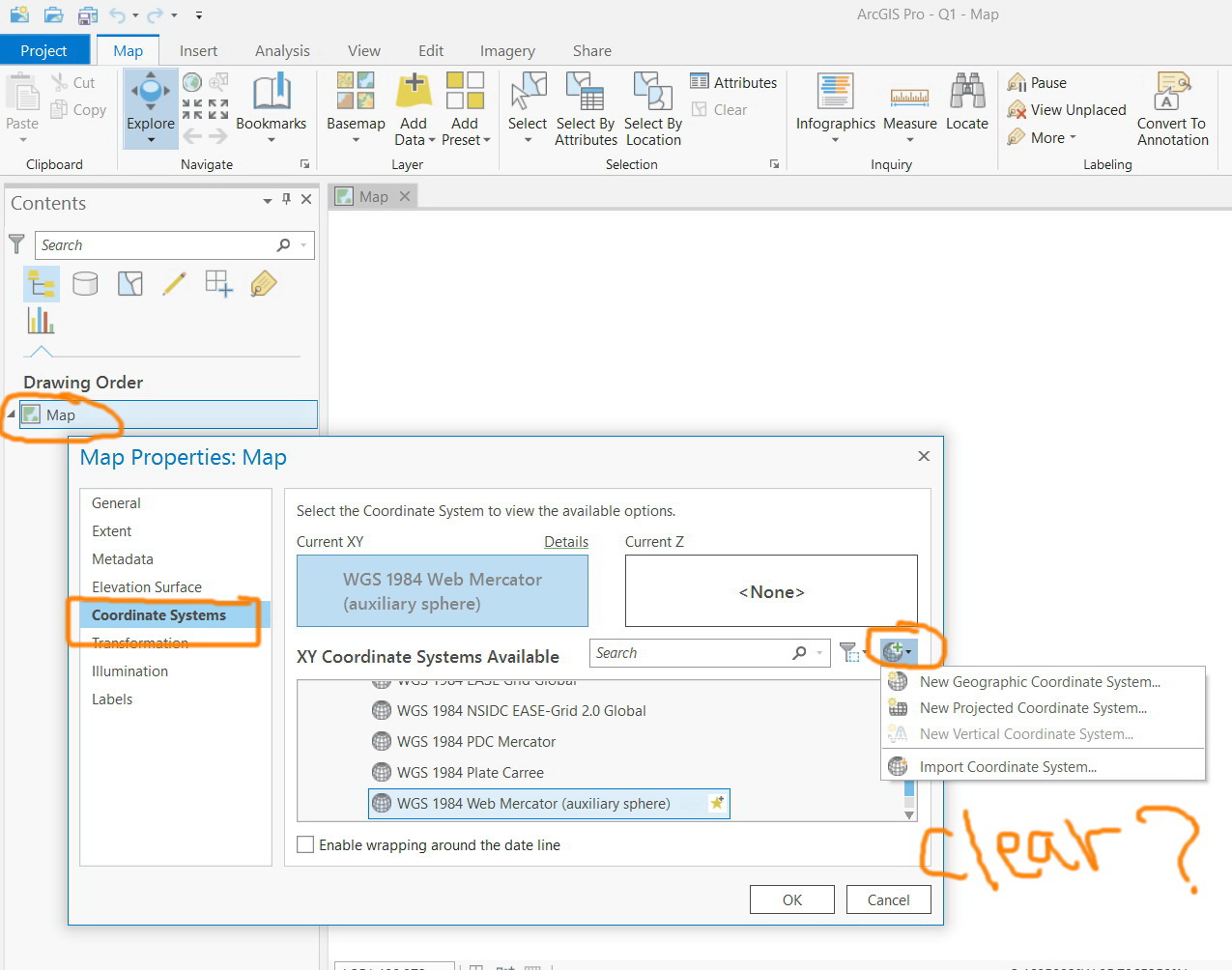- Home
- :
- All Communities
- :
- Products
- :
- ArcGIS Pro
- :
- ArcGIS Pro Questions
- :
- Re: How to “clear” the coordinate system of the “M...
- Subscribe to RSS Feed
- Mark Topic as New
- Mark Topic as Read
- Float this Topic for Current User
- Bookmark
- Subscribe
- Mute
- Printer Friendly Page
How to “clear” the coordinate system of the “Map” to get it to “unknown” in ArcGIS Pro,
- Mark as New
- Bookmark
- Subscribe
- Mute
- Subscribe to RSS Feed
- Permalink
How to “clear” the coordinate system of the “Map” to get it to “unknown” in ArcGIS Pro,
For example, in ArcMap, the clear option is available and one can set the “data frame” to unknown. I couldn’t figure out how to “clear” the coordinate system of the “Map” to get it to “unknown” in ArcGIS Pro as this option is not there


Jamal Numan
Geomolg Geoportal for Spatial Information
Ramallah, West Bank, Palestine
- Mark as New
- Bookmark
- Subscribe
- Mute
- Subscribe to RSS Feed
- Permalink
Hi Melita, your suggestion works if the coordinate system is undefined, but what if it is labeled incorrectly? All you have left us with is checking the extent against the label which only works in obvious cases like decimal degree data labeled as UTM. I wonder what Margaret Maher thinks as I know she uses this functionality in her great 'cookbooks' to solve problems in her (excellent) Esri press book Lining Up Data.
- Mark as New
- Bookmark
- Subscribe
- Mute
- Subscribe to RSS Feed
- Permalink
Hi Curtis,
How is this any different than working with it in ArcMap? Yes, you can set the data frame to be "unknown" and see the bad data offset because it's not being projected-on-the-fly. Whether it's getting projected on-the-fly or not, the data must be offset or you wouldn't realize that there's something wrong with it.
In Pro, the data's still offset. You still need reference data that has the correct coordinate system that you can use to compare against the questionable data. Switch the map between the reference data's coordinate system and the bad data's coordinate system. That will tell you the offset. Bad data is 3x too big or small, there's a unit issue. Data is directly north-south--possibly an ellipsoid/sphere (like Web Mercator versus World Mercator).
Melita
- Mark as New
- Bookmark
- Subscribe
- Mute
- Subscribe to RSS Feed
- Permalink
Melita,
I think we are talking about getting the 'ArcMap' functionality, into ArcPro.
I think that Jamal NUMAN is saying, is that it does NOT work that way in ArcPro.
Apologies if I'm missing something.
Greg
- Mark as New
- Bookmark
- Subscribe
- Mute
- Subscribe to RSS Feed
- Permalink
projection on the fly JPEG - yuck! Definitely going on a lecture slide!
- Mark as New
- Bookmark
- Subscribe
- Mute
- Subscribe to RSS Feed
- Permalink
You're welcome. 🙂
- Mark as New
- Bookmark
- Subscribe
- Mute
- Subscribe to RSS Feed
- Permalink
Hello Melita,
Sorry to bring this topic up again, but in ArcMap, the option "unknown" works so good for many many years, I really can't see how could there be "too many side issues" for that in ArcGIS Pro.
And there is another good reason for "unknown" to exsit is for local refence.
Some data uses local or regional coordinate system that doesn't exist in Pro. So we have to reset them to "unknown" and then define project to something that in the system. That way we keep the original coordinates(and it's location) put them into a new refrence without transformation.
To be clear, we always choose the new refrence with closest central meridian to avoid and minimal the deformation.
In fact, the entire support of coordinate systems has been declined since the good old ArcMap. In Pro we can still use a prj file to define local refrence, but not in Enterprise.
So not only we want a "unknown" option in Pro, we also want an upgrade in local refence on all Esri platform, if it's possible.
Thank you.
Karl
- Mark as New
- Bookmark
- Subscribe
- Mute
- Subscribe to RSS Feed
- Permalink
What he said!
- Mark as New
- Bookmark
- Subscribe
- Mute
- Subscribe to RSS Feed
- Permalink
Setting projection to unknown is a standard practise if you want to find out what the raw unprojected coordinates are. I used to do this all the time but can't in ArcGIS PRO and ArcMap 10.7.1 crashes if I do this.
How else can you check the "actual" raw data locations of imagery with swipe if you have projections and transformations set?
I see data sets all the time that have incorrect projection information. Load them into arc with no projection and you can see the displacement in the raw coordinate values.. beats removing the projection files...
Local planar two point grids as used in the Minerals and Mining industry cannot, as far as I know, be defined in arc so data from them often remains without a projection file.
- Mark as New
- Bookmark
- Subscribe
- Mute
- Subscribe to RSS Feed
- Permalink
This goes back to the original point I was trying to make earlier in this discussion. The ability to have an unknown and arbitrary plane "projection" allows for the use of all kinds of data in the GIS. It is a powerful functionality that exists in ArcGIS Desktop (a rare +1 for ArcGIS Desktop) and allows the user to put any kind of data they want into the system. Taking away that functionality is limiting the users. There is no way ESRI can know all the ways their software is being used. Software should never be limiting just to be limiting. Put this functionality back into ArcPro, users will have to be knowledgeable about GIS to get the tools that require projections to function properly, and put this discussion to rest.
- Mark as New
- Bookmark
- Subscribe
- Mute
- Subscribe to RSS Feed
- Permalink
This issue was logged as BUG-000114029 in May 2018, and has been marked as "Not in Current Product Plan by Esri Development. However, effective with version 2.7 of ArcGIS Pro, it is possible to add data to the Pro project that does not have a projection defined. In earlier versions, a default coordinate system was assigned to the data - either GCS_WGS_1984, or WGS_1984_Web_Mercator_Auxiliary_Sphere - which were wrong in most cases.
The extent of the data which has the unknown projection definition can be viewed in the Catalog Pane in ArcGIS Pro, and with some preliminary research about coordinate extents for the area, in commonly used coordinate systems for the area, it is usually pretty easy to figure out what projection the data was created in. If nothing matches, i.e. CAD data, it may be necessary to create a custom projection file to align the data.
The fundamental issue to remember is that Project on the Fly works. If the data has a projection defined, and you have set the appropriate datum transformation, but the data does not show up in the correct location, the assigned projection is wrong. Clear that projection definition, and follow instructions in Knowledge article 000007880 and related articles to identify the coordinate system, or create a custom projection to align the data.